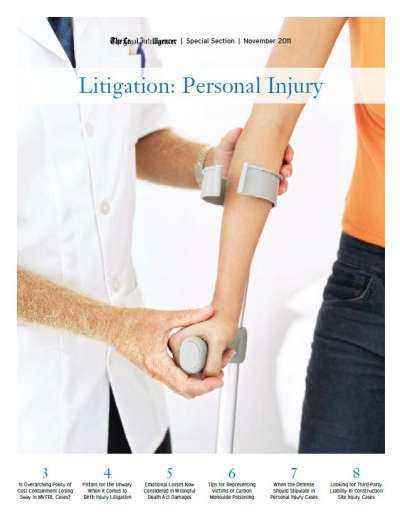Tom Duffy article: “Birth Injury Litigation: Pitfalls for the Unwary”
While the stakes can vary considerably in personal injury litigation, they are seldom higher than in cases involving a significant birth injury. The injuries can be devastating to the child and have repercussions for the child and family members that will persist for generations. The potential damage awards insure that the cases are aggressively defended by experienced defense counsel backed by large institutional clients who are willing to spare no expense and hire premier experts to defend their reputation and prevent a multimillion dollar jury verdict. There are a myriad of injuries that can occur to a baby during the birthing process including brain damage (leading to cerebral palsy), brachial plexus injuries, nerve damage, and orthopedic injuries. In almost every birth injury case you can expect the healthcare provider to argue the injury was not their fault, was not preventable, was not from the birthing process, happened long before the mother arrived at the hospital or all of the above. This article will focus on some of the common causation defenses relied upon in birth injury cases involving cerebral palsy and the important evidence needed to refute them.
Apgar Scores
Perhaps the most widely talked about and commonly known tool used in the assessment of the general condition of a newborn at birth is the Apgar score. An Apgar score is a serial assessment of the newborn based on five clinical criteria typically documented at one minute, five minute, ten minute and sometimes twenty minutes of life. The evolving trend of healthcare providers has been to place undue emphasis on a “good” five minute Apgar score to disprove a claim that a baby’s diagnosis of cerebral palsy was secondary to a brain injury that occurred during the birthing process. Typically, if a child’s five minute Apgar is six (6) or above the defense will argue the baby’s brain damage and cerebral palsy could not have been caused by the circumstances immediately surrounding the mother’s labor and delivery.
The Apgar score assessment includes a scoring of 0, 1 or 2 for the following criteria: color, tone, pulse, respiration, and reflex. The baby is given a score of 0, 1 or 2 depending upon the baby’s appearance, muscle tone, pulse, response to stimulation, and respiration. The average five minute Apgar score for infants delivered at term is 9. Usually, the scoring is done by someone other than the delivering obstetrician. If there is a neonatologist present at the delivery, they will score the Apgar assessment. If not, it is done by a labor and delivery nurse. The first step in unraveling this defense is to get to the raw scoring which is normally set forth in the “labor and delivery” summary and in the baby’s chart. It is not uncommon to see a baby incorrectly given a score of 2 for pulse when the baby’s pulse was in the 90s (heart of rate > 100 bpm = 2).
Second, even though the scoring is done by someone other than the delivering obstetrician, you must look for the possibility of bias in the scoring. Our law firm conducted discovery in a case where a child diagnosed with cerebral palsy was given a five minute Apgar score of 7. This “good” five minute Apgar was one of the pillars of the causation defense. The raw scoring mysteriously was never documented in the chart and was done by the neonatologist who just happened to be married to the defendant obstetrician. Another factor that can artificially inflate a child’s five minute Apgar score is the nature and extent of neonatal resuscitation. As you might imagine, it can be difficult to assess a child’s respiratory effort once a tube has passed through his nose into his lungs to assist breathing. Multiple studies have demonstrated that observer Apgar scores varied greatly after neonatal resuscitation was performed. The original purpose of the Apgar test was only as a quick method for classifying the general condition of a newborn. The test was never intended to prognosticate neurological injury and its long term sequelae. Nevertheless, knowing how, and on what basis, to unravel the potential for Apgar mis-scoring may diffuse a well armed opponent.
Blood Gas Results
Acute birth asphyxia is an interference with respiration resulting in hypoxia and tissue acidosis occurring near the time of birth. A common defense in cases involving traumatic deliveries and babies diagnosed with cerebral palsy is that the baby could not have been subject to birth asphyxia unless the umbilical cord Ph was less then 7.0. Fetal or neonatal blood can be tested for Ph, oxygen (pO2), carbon dioxide (pCO2), bicarbonate (HCO3) and base excess (BE levels). The Ph can fluctuate with changes in the quantity of carbon dioxide in the blood. Despite the insistence of healthcare providers and their experts that in the absence of a cord Ph of 7.0 or lower, the baby’s injuries could not have come from the birthing process, there is now substantial medical literature demonstrating a connection between asphyxial brain damage with higher Ph levels. More importantly, sampling errors are common and you can have a normal venous Ph with arterial acidemia. Thus, what is reported as a normal Ph from the umbilical artery may have been from the umbilical vein. Unless both results are reported and serial tests are done, do not dismiss the possibility of an asphyxial injury from birth if other factors point in that direction. It is also possible for an infant to suffer an asphyxial brain injury without acidemia. An infant could produce acid in the tissues without developing circulating academia if there were a complete circulatory arrest; acid could accumulate in the tissues but not enter the blood stream until after resuscitation and circulation had been restored. Such an event would skew widely the results of a single testing of the umbilical cord’s arterial blood Ph.
Electronic Fetal Monitoring
In modern obstetrics it is unlikely you will ever evaluate a potential case involving labor and delivery where the fetus was not subject to electronic fetal heart rate monitoring for at least some period of time prior to delivery. The fetal brain controls the fetal heart rate. The fetal heart rate should change in reaction to stimulation. Fetal heart rate monitoring can be used to assess whether the fetus is well oxygenated and tolerating labor. In almost every case involving an allegation of a delay in delivery, the healthcare providers will argue that they acted timely once it became apparent the baby was in distress. In this part of the country, hospitals uniformly fail to produce the electronic fetal heart rate monitoring records (strips) when the mother’s records are initially requested. Many excuses are offered but the most obvious reason is that the strips often contain irrefutable evidence of a smoldering problem that the healthcare providers either ignored or failed to appreciate before it was too late.
In its simplest terms, electronic fetal heart rate monitoring provides a real time picture of the baby’s heart rate and the mother’s contraction pattern. When a fetus is exposed to asphyxia he does not immediately develop brain damage because he can compensate and redistribute blood flow to the brain. This compensatory response provides time depending upon the severity and nature of the asphyxial exposure for the healthcare providers to appreciate that a fetus is at risk for brain damage and if necessary, intervene before irreversible brain damage occurs.
Fetal heart rate (FHR) monitoring may be performed externally or internally. Most external monitors use a Doppler device to interpret and count the signals. Internal FHR monitoring is accomplished with a fetal electrode, which is a spiral wire placed directly on the fetal scalp or other presenting part. The baby’s heart rate, assuming a close to term gestation, should be in the range of 110 to 160 beats per minute. In addition to the general range, the baseline can be assessed to determine variability. Fluctuations in the baseline that are irregular and variable in frequency are evidence of a healthy fetus tolerating labor. A baseline with a minimal or absent variability is an ominous sign since it suggest the baby is no longer compensating. Thus, a strip that looks “flat” is worrisome and requires closer monitoring and, potentially, intervention. Another basic measurement considered when reviewing a fetal heart rate monitoring strip is the relationship of the baby’s heart beat to the mother’s contraction pattern. The presence and absence of accelerations and decelerations in the fetal heart rate are also important signs of how well the baby is tolerating labor. Repetitive late decelerations (a drop in the baby’s heart rate after the nadir of the contraction) with a slow return to baseline are usually a sign that the baby is decompensating and needs to be delivered expediently.
Not every birth injury is the result of negligence. However, no single piece of medical evidence standing alone should be permitted to defeat a birth injury case where the totality of the circumstances point to negligent management of labor and delivery as the cause. When the defense points to an Apgar score, dig deeper, get the raw score, question every assumption upon which it was based. Depose the delivery room nurses and get to the truth. The same holds true for test results. Never accept a single cord Ph test as conclusive proof that a baby’s injuries could not have come from a delay in delivery. Always, always get the fetal monitoring strips for very case. They often tell the story the hospital does not want you to know. Accept nothing at face value. As you well know this is your client’s only chance at justice – this is their only case.
Tom Duffy of Duffy + Partners focuses his work entirely on catastrophic personal injury litigation. To learn more about the firm visit www.duffyfirm.com.

This article originally appeared in a special "Personal Injury Litigation" supplement of The Legal Intelligencer on Tuesday, November 15, 2011.

